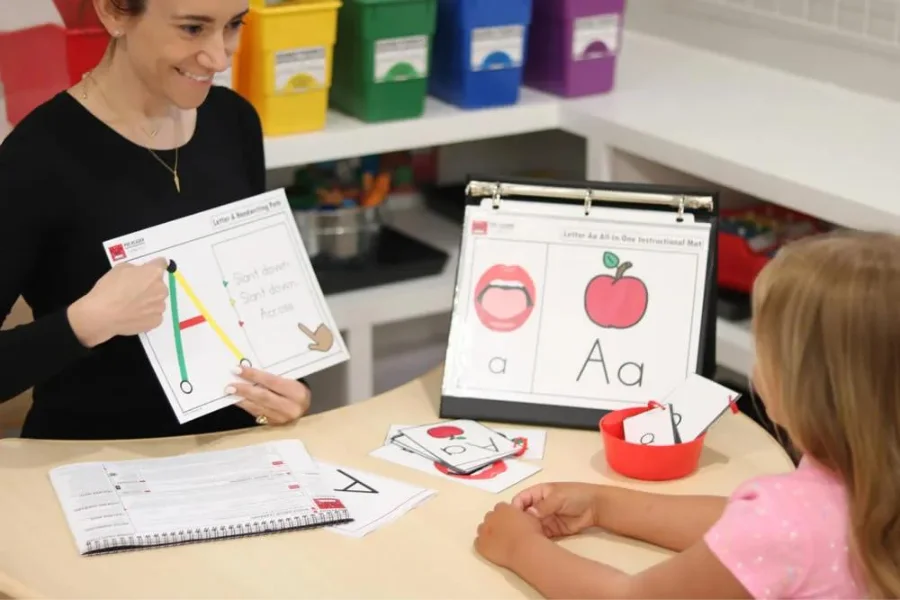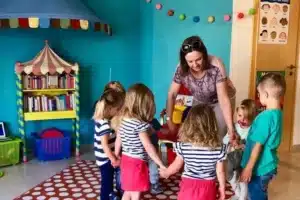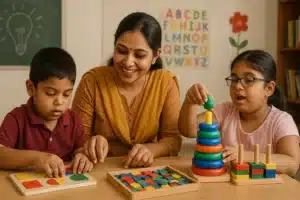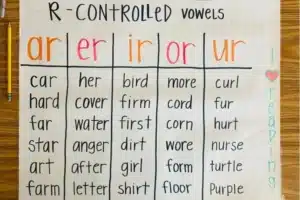
Source: abcsofliteracy
Phonics is a crucial aspect of early education; it is an approach to teaching letters and their associated sounds to children in a pleasurable way.
There are certain Fun Ways to Teach Phonics to Kindergarteners to make it effective and appealing to young children. These include incorporating rhymes, songs, games, and hands-on activities.
Rhyming and reading picture books aloud introduce sounds and language to children, making phonics easily comprehensible. Singing appealing songs is another great way to captivate children’s attention and teach letter sounds effortlessly. With these fun ways to teach phonics, learning becomes an exploration of curiosity and early language skills.
Enquire now for Phonics Course via Call / Whatsapp on +918104606573 / +919869866277.
Our comprehensive Phonics Course brochure is, Available Here.

Source: toddlerjunction
Steps to Teach Phonics to Kindergarteners
Teaching Phonetic Sounds to Kindergarteners is an exciting activity that requires dedication and enthusiasm. Educators can build foundational reading and language skills by using interactive ways and following essential Steps to Teach Phonics to Kindergarteners.
Here’s how to approach teaching phonics to young learners:
Start with Letter Recognition
Begin by helping children recognize letters and their corresponding sounds. Activities like “Flip the Pancake” make this process enjoyable. An activity where children are allowed to shape letters from Play-Dough while observing a flashcard for reference. Cutting circles out of construction paper, write letters on them, and ask children to flip them over with a spatula while saying the letter name. This Fun Ways to Teach Phonics makes learning tactile.
Focus on Sounds
Once children are familiar with letters, emphasize their sounds. Games like “Letter Swat” allow children to match letter sounds to written letters by swatting sticky notes with a fly swatter. Another option is the “Word Roller,” where children roll a ball back and forth while naming words that begin with a given sound. These games reinforce phonemic awareness and make learning dynamic.
Incorporate Movement
For children who love to move, incorporate physical activities into phonics learning. “Magazine Scavenger Hunt” encourages kids to find images in magazines or newspapers that begin with a particular sound. “Word Walk” involves writing simple words on the pavement with chalk and having children walk along while sounding out the words, these activities are beneficial in keeping children engaged while helping them connect sounds to visuals.
Blend and Segment Sounds
Teach children to combine and separate sounds with activities like “CVC Cups.” Label three cups with consonants, vowels, and consonants, respectively, and have children rotate the cups to create simple words. Similarly, “Phonics Dice” uses dice with letters to help children form words by blending the rolled letters.
Use Everyday Opportunities
Phonics practice doesn’t have to be limited to structured activities. Games like “I Spy” are perfect for practicing sounds on the go. Simply describe something that starts with a specific sound, and let the child guess what it is. You can also use “Popsicle Stick Questions” to engage older children by asking comprehension questions about stories they’ve read.
These fun ways to teach phonics create an enjoyable classroom environment that fosters curiosity and confidence. Integrating phonics into everyday activities, helps children develop strong language skills while keeping the process playful and exciting.

Source: littlemindsatwork
Teaching Aids to Teach Phonics
Phonics Teaching is an exciting experience but thought-provoking, therefore, certain teaching aids are required to effectively provide interactive learning sessions that serve the purpose of educational goals. They help to simplify learning and make a lasting impact on children.
Here are some essential aids to consider:
Alphabet Cards and Flashcards
Colorful alphabet flashcards are great for introducing letters and sounds. Use them in matching games or blending activities, like forming simple words by combining multiple cards.
Magnetic Letters and Boards
This aids children to move letters around on a magnetic board to build words or learn letter placement. It is a helpful aid that teaches phonics while improving the motor skills of children.
Phonics Games and Puzzles
Board games, puzzles, and phonics-based activities like bingo or letter-matching games make phonics practice enjoyable while reinforcing sound recognition and word-building skills.
Manipulative
Tools like play dough help children form letters and connect shapes to sounds. Similarly, letter tiles or blocks allow kinaesthetic learners to physically manipulate letters to create words.
Storybooks and Picture Books
Books with rhymes and repetitive sounds are excellent for phonics practice. Encourage children to identify letters and sounds within the text during reading time.
Digital Resources
Interactive apps and online tools provide games and audio support for phonics, helping children hear and practice sounds accurately.
Rhymes and Engaging Songs
Phonics songs and rhymes help children learn sound patterns enjoyably and memorably.
These aids accurately pass muster to teach phonetic sounds to young children. With Phonics Course trainees learn the principles of phonics study and master the Fun Ways to Teach Phonics.
Best Phonics Teacher Training Course
Looking for the best Phonics Teacher Training Course can be complicated, as there are billions of options available but only a few provide reliable knowledge of phonics. It is always virtuous to go for institutes that offer govt. the certified program, Vidhyanidhi Education Society is an institute that has been serving society for the past 15 years with its reliable and top-quality courses. Their Phonics program aims to prepare teachers with the complete expertise to nurture children’s growth and provide the Fun Ways to Teach Phonics.
Below are the benefits of Phonics Course:
Enhanced Teaching Methods
Acquire expertise in teaching phonics through interactive and structured approaches.
Confidence Building
Learn to handle diverse classroom challenges while fostering a love for reading among students.
Career Advancement
Receiving global1 certification that enhances career prospects in early childhood education.
The Phonics Teacher Training Course from Vidhyanidhi Education Society aims to provide a comprehensive understanding of phonics principles and teaching techniques.
Course Curriculum:
Introduction to Phonics
Basics of sounds, blending, segmenting, and letter-sound associations.
Phonics Rules and Sounds
Understanding letter sound, vowels, consonants, and their blends.
Segmenting and Blending Techniques
Teaching children to form and break words effortlessly.
Word Families and Sight Words
Exploring common patterns and essential high-frequency words.
Phonics Games and Activities
Interactive teaching aids to make phonics fun and engaging.
Evaluation and Remedial Techniques
Identifying learning gaps and addressing them effectively.
Lesson Planning
Crafting structured and impactful phonics lessons.
Trainees gain the knowledge and expertise required to make teaching phonics an engaging learning experience for children through Vidhyanidhi Education Society’s (Govt. Regd.) phonics program. Mothers, teachers, and caregivers who wish to upgrade their teaching skills to higher dimensions can conveniently opt for this program.
Make Phonics learning magical! Join Vidhyanidhi Education Society’s Phonics Course and Teach with joy!
Enquire now for Phonics Course via Call / Whatsapp on +918104606573 / +919869866277.
Our comprehensive Phonics Course brochure is, Available Here.
FAQs
How to Make Kindergarten Phonics Fun?
Incorporate games like letter swat, use songs and rhymes, engage in hands-on activities with play dough, and add movement through activities like a word walk.
How do you Teach Phonics Creatively?
Use storytelling, craft-based letter-making, interactive games, and music to blend learning with fun. Tailor activities to students' interests for better engagement.
Which is the Best Method for Teaching Phonics in the Classroom?
A systematic synthetic phonics approach works best, blending sounds to form words, paired with interactive tools like flashcards, games, and group activities.



